Abstract
The bronchodilating efficacies and beta2-adrenoceptor selectivities of rimiterol (0.2, 0.1, and 0.05 mug kg-minus1 min-minus1) and sal-utamol (0.1, 0.5, and 0.025 mug kg-minus1 min-minus1), intravenously infused for one hour, were determined in five patients with chronic asthma. Each drug infusion produced and maintained a dose-related improvement in forced expiratory volune in one second (FEV1). A further increase in FEV1 was produced by inhalation of the same drug by pressurized aerosol at the end of each infusion, which suggested that no resistance had occurred. Similar dose-related increases in heart rate, pulse pressure, and skeletal muscular tremor were produced by each drug. Peak heart rate increases varied greatly between individuals, ranging from 12 to 30 beats/min with the high doses but always less than 10 beats/min with the low doses of each drug. On rimiterol the heart rate reached equilibrium earlier during the infusions and declined more rapidly after they had stopped, thus providing an accurate means for monitoring dosage. Rimeterol with its short half life-a desirable property for an intravenous drug with respect to safety-may prove to be a valuable bronchodilator in severe asthma when intravenous infusions are indicated.
Full text
PDF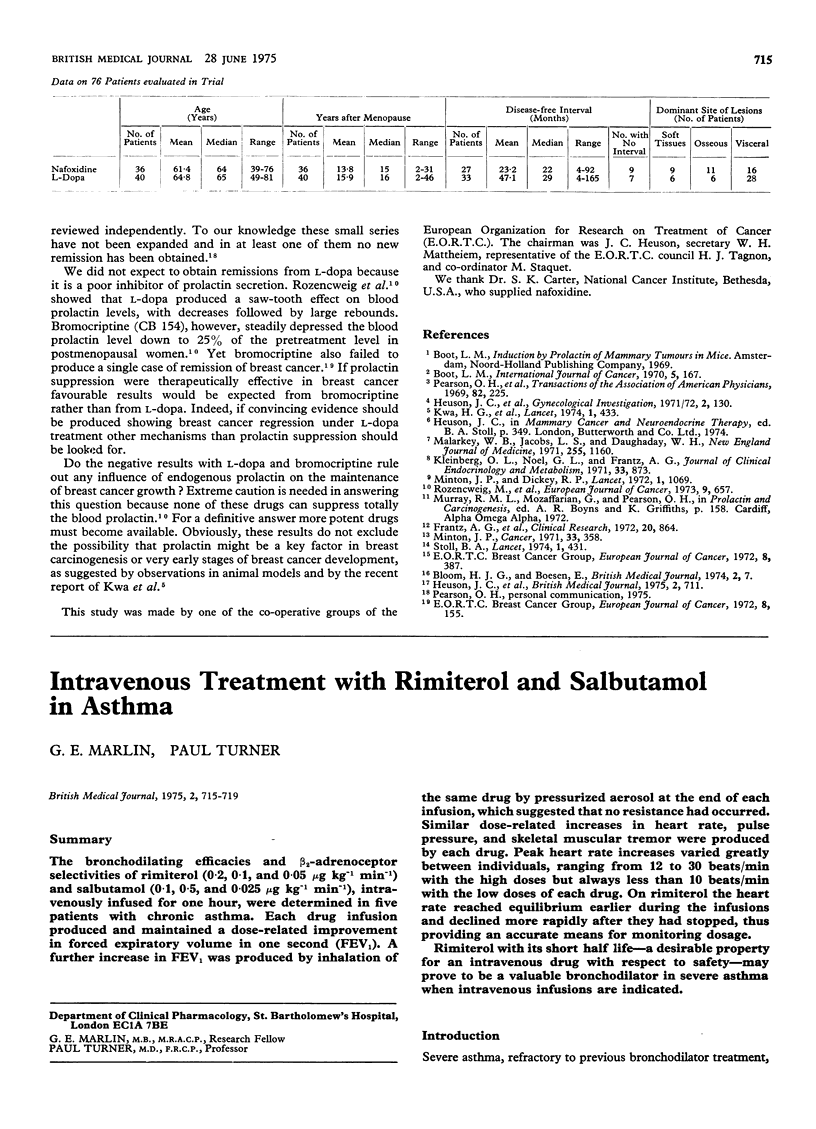
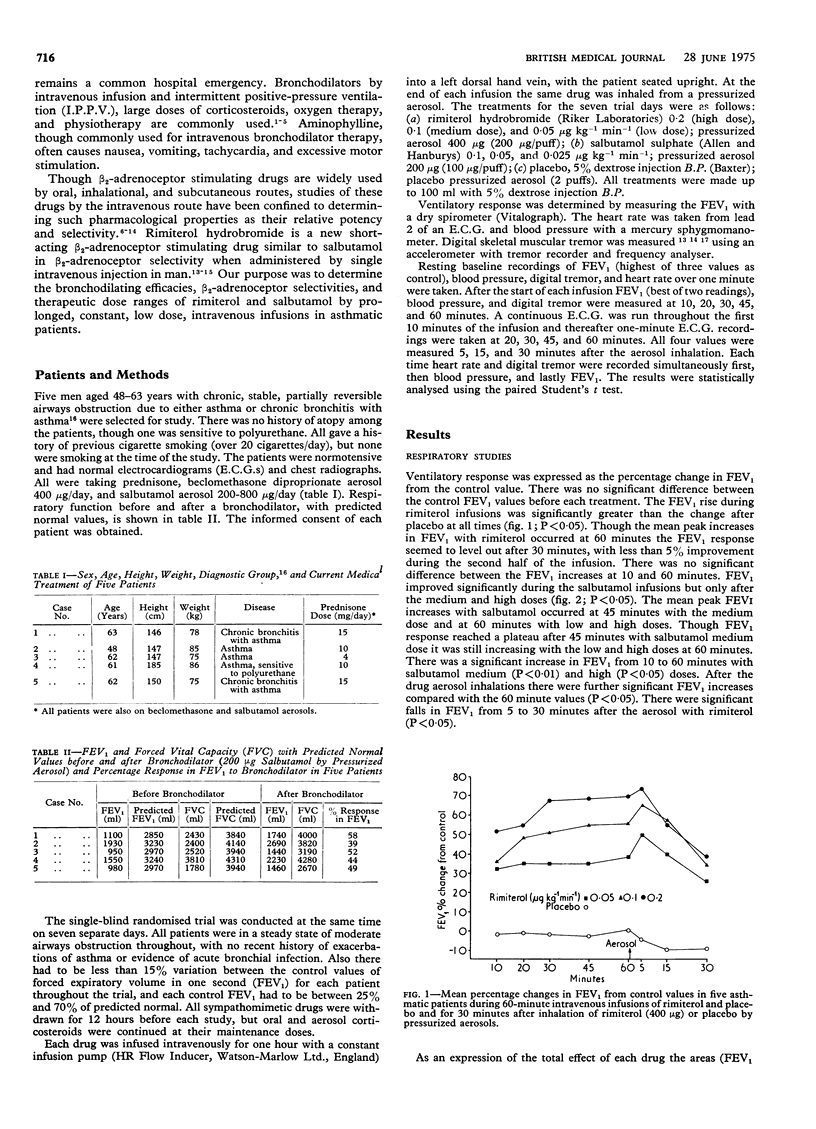
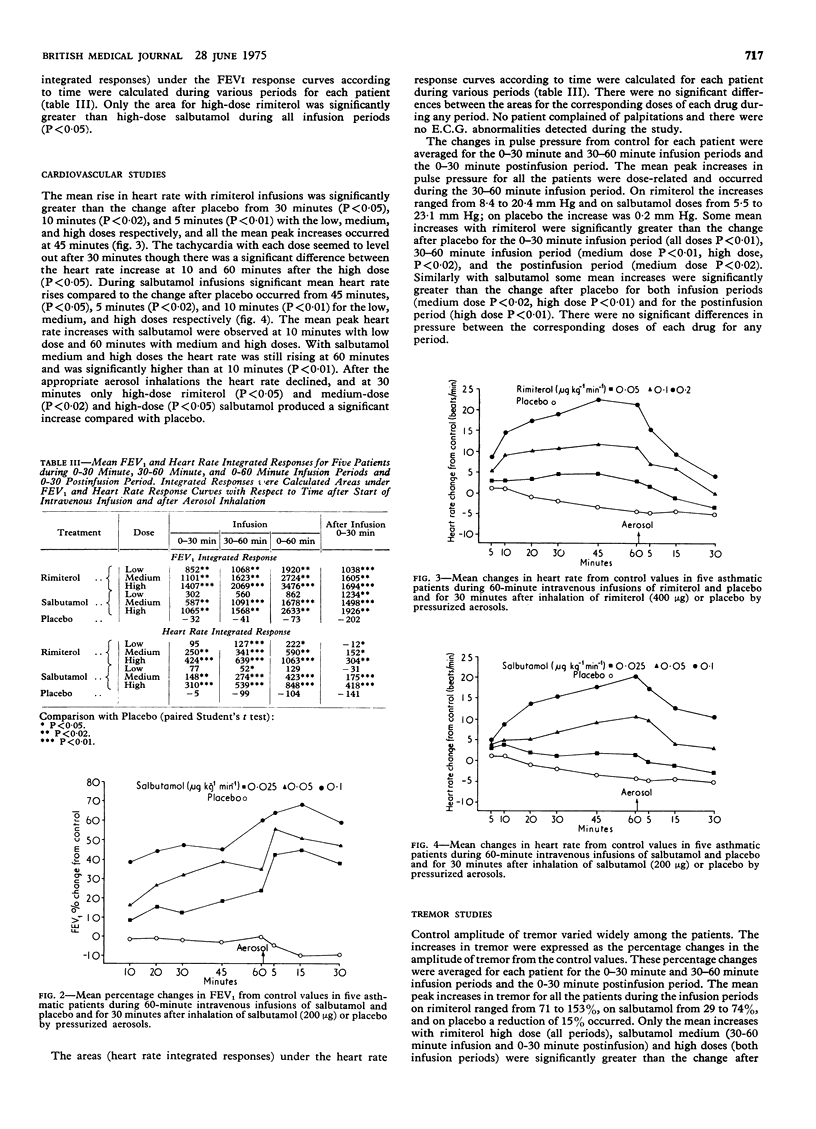
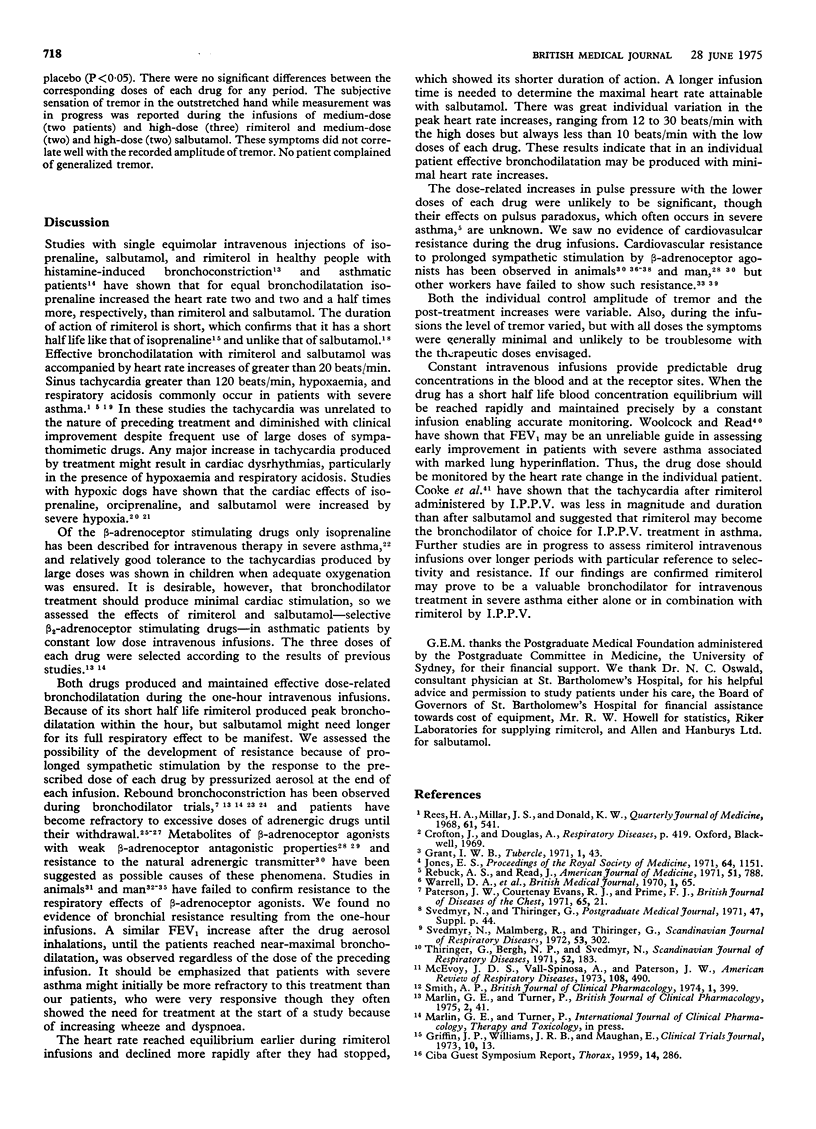
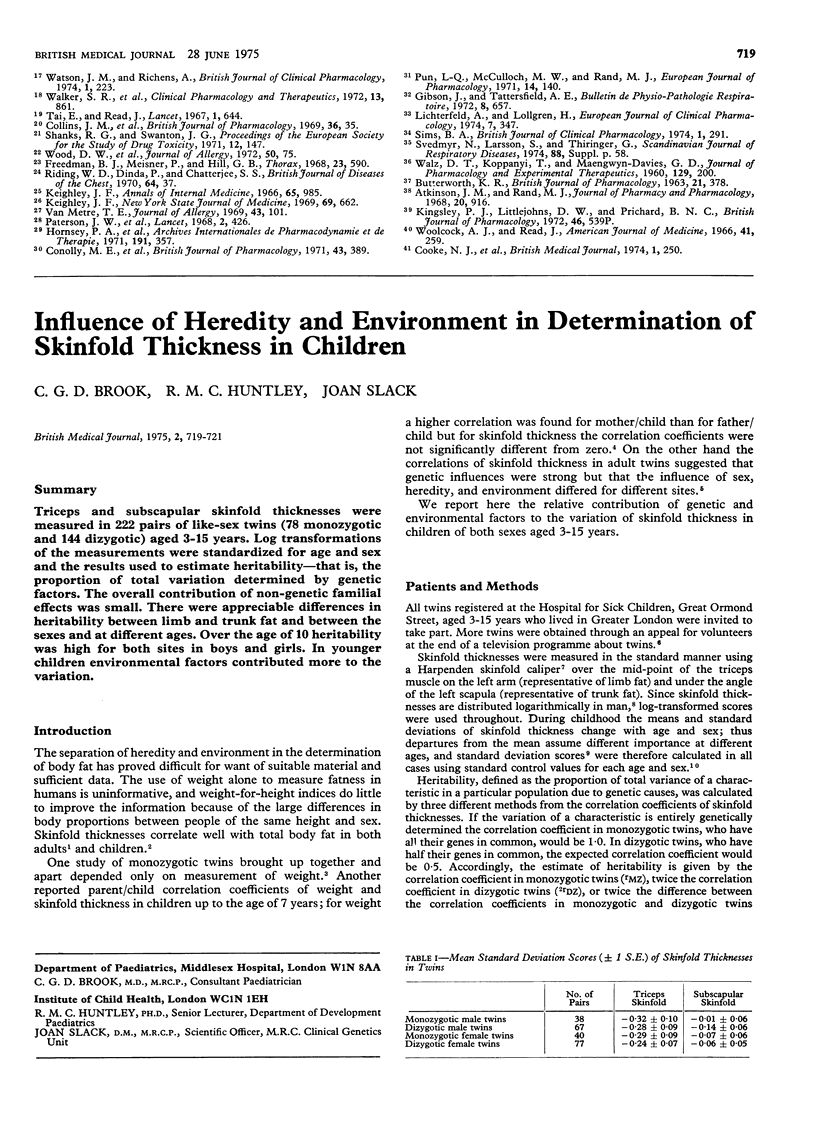
Selected References
These references are in PubMed. This may not be the complete list of references from this article.
- Atkinson J. M., Rand M. J. Mutal suppression of cardiovascular effects of some beta-adrenoreceptor agonists in the cat. J Pharm Pharmacol. 1968 Dec;20(12):916–922. doi: 10.1111/j.2042-7158.1968.tb09674.x. [DOI] [PubMed] [Google Scholar]
- BUTTERWORTH K. R. THE BETA-ADRENERGIC BLOCKING AND PRESSOR ACTION OF ISOPRENALINE IN THE CAT. Br J Pharmacol Chemother. 1963 Oct;21:378–392. doi: 10.1111/j.1476-5381.1963.tb01536.x. [DOI] [PMC free article] [PubMed] [Google Scholar]
- Collins J. M., McDevitt D. G., Shanks R. G., Swanton J. G. The cardio-toxicity of isoprenaline during hypoxia. Br J Pharmacol. 1969 May;36(1):35–45. doi: 10.1111/j.1476-5381.1969.tb08301.x. [DOI] [PMC free article] [PubMed] [Google Scholar]
- Conolly M. E., Davies D. S., Dollery C. T., George C. F. Resistance to -adrenoceptor stimulants (a possible explanation for the rise in ashtma deaths). Br J Pharmacol. 1971 Oct;43(2):389–402. [PMC free article] [PubMed] [Google Scholar]
- Cooke N. J., Kerr J. A., Willey R. F., Hoare M. V., Grant I. W., Cromptom G. K. Response to rimiterol and salbutamol aerosols administered by intermittent positive-pressure ventilation. Br Med J. 1974 May 4;2(5913):250–252. doi: 10.1136/bmj.2.5913.250. [DOI] [PMC free article] [PubMed] [Google Scholar]
- Freedman B. J., Meisner P., Hill G. B. A comparison of the actions of different bronchodilators in asthma. Thorax. 1968 Nov;23(6):590–597. doi: 10.1136/thx.23.6.590. [DOI] [PMC free article] [PubMed] [Google Scholar]
- Hornsey P. A., Gailer K. A., Turner P., Griffin J. P. Studies of the 3,methoxy-derivatives of isoprenaline, isoetharine and WG 253 on isolated human tissue. Arch Int Pharmacodyn Ther. 1971 Jun;191(2):357–364. [PubMed] [Google Scholar]
- Jones E. S. The intensive therapy of asthma. Proc R Soc Med. 1971 Nov;64(11):1151–1152. [PMC free article] [PubMed] [Google Scholar]
- Keighley J. F. Iatrogenic asthma associated with adrenergic aerosols. Ann Intern Med. 1966 Nov;65(5):985–995. doi: 10.7326/0003-4819-65-5-985. [DOI] [PubMed] [Google Scholar]
- Keighley J. F. Refractory asthma and adrenergic aerosols. N Y State J Med. 1969 Mar 1;69(5):662–667. [PubMed] [Google Scholar]
- Kingsley P. J., Littlejohns D. W., Prichard B. N. Isoprenaline-induced tachycardia in man. Br J Pharmacol. 1972 Nov;46(3):539P–540P. [PMC free article] [PubMed] [Google Scholar]
- Lichterfeld A., Löllgen H. Investigation into isoprenaline resistance in patients with obstructive lung disease. Eur J Clin Pharmacol. 1974 Aug 23;7(5):347–351. doi: 10.1007/BF00558204. [DOI] [PubMed] [Google Scholar]
- McEvoy J. D., Vall-Spinosa A., Paterson J. W. Assessment of orciprenaline and isoproterenol infusions in asthmatic patients. Am Rev Respir Dis. 1973 Sep;108(3):490–500. doi: 10.1164/arrd.1973.108.3.490. [DOI] [PubMed] [Google Scholar]
- Paterson J. W., Conolly M. E., Davies D. S., Dollery C. T. Isoprenaline resistance and the use of pressurised aerosols in asthma. Lancet. 1968 Aug 24;2(7565):426–429. doi: 10.1016/s0140-6736(68)90467-4. [DOI] [PubMed] [Google Scholar]
- Pun L. Q., McCulloch M. W., Rand M. J. Bronchodilator effects of sympathomimetic amines given singly and in combination. Eur J Pharmacol. 1971 Apr;14(2):140–149. doi: 10.1016/0014-2999(71)90207-x. [DOI] [PubMed] [Google Scholar]
- Rebuck A. S., Read J. Assessment and management of severe asthma. Am J Med. 1971 Dec;51(6):788–798. doi: 10.1016/0002-9343(71)90307-x. [DOI] [PubMed] [Google Scholar]
- Rees H. A., Millar J. S., Donald K. W. A study of the clinical course and arterial blood gas tensions of patients in status asthmaticus. Q J Med. 1968 Oct;37(148):541–561. [PubMed] [Google Scholar]
- Riding W. D., Dinda P., Chatterjee S. S. The bronchodilator and cardiac effects of five pressure-packed aerosols in asthma. Br J Dis Chest. 1970 Jan;64(1):37–45. doi: 10.1016/s0007-0971(70)80047-x. [DOI] [PubMed] [Google Scholar]
- Svedmyr N., Malmberg R., Thiringer G. The effect of a new adrenergic beta 2 -receptor-stimulating agent (rimiterol, R798) in patients with chronic obstructive lung disease. Scand J Respir Dis. 1972;53(5):302–313. [PubMed] [Google Scholar]
- Tai E., Read J. Blood-gas tensions in bronchial asthma. Lancet. 1967 Mar 25;1(7491):644–646. doi: 10.1016/s0140-6736(67)92541-x. [DOI] [PubMed] [Google Scholar]
- Thiringer G., Bergh N. P., Svedmyr N. A comparative study of the effects of isoetharine and some other adrenergic beta-stimulators in chronic obstructive lung disease. Scand J Respir Dis. 1971;52(4):183–191. [PubMed] [Google Scholar]
- Van Metre T. E., Jr Adverse effects of inhalation of excessive amounts of nebulized isoproterenol in status asthmaticus. J Allergy. 1969 Feb;43(2):101–113. doi: 10.1016/0021-8707(69)90130-0. [DOI] [PubMed] [Google Scholar]
- WALZ D. T., KOPPANYI T., MAENGWYN-DAVIES G. D. Isoproterenol vasomotor reversal by sympathomimetic amines. J Pharmacol Exp Ther. 1960 Jun;129:200–207. [PubMed] [Google Scholar]
- Walker S. R., Evans M. E., Richards A. J., Paterson J. W. The clinical pharmacology of oral and inhaled salbutamol. Clin Pharmacol Ther. 1972 Nov-Dec;13(6):861–867. doi: 10.1002/cpt1972136861. [DOI] [PubMed] [Google Scholar]
- Warrell D. A., Robertson D. G., Howes J. N., Conolly M. E., Paterson J. W., Beilin L. J., Dollery C. T. Comparison of cardiorespiratory effects of isoprenaline and salbutamol in patients with bronchial asthma. Br Med J. 1970 Jan 10;1(5688):65–70. [PMC free article] [PubMed] [Google Scholar]
- Woolcock A. J., Read J. Lung volumes in exacerbations of asthma. Am J Med. 1966 Aug;41(2):259–273. doi: 10.1016/0002-9343(66)90021-0. [DOI] [PubMed] [Google Scholar]


